The Inscrutable Volbach Portrait Page at The Face Of Bach
The Face Of Bach
This remarkable photograph is not a computer generated composite; the original of the Weydenhammer Portrait Fragment, all that
remains of the portrait of Johann Sebastian Bach that belonged to his pupil Johann Christian Kittel, is resting gently on the surface
of the original of the 1748 Elias Gottlob Haussmann Portrait of Johann Sebastian Bach.
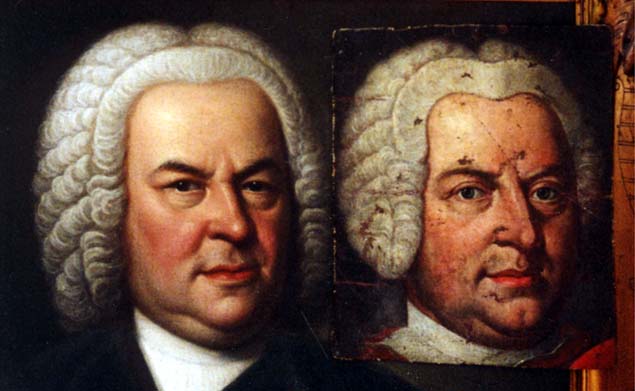
1748 Elias Gottlob Haussmann Portrait, Courtesy of William H. Scheide, Princeton, New Jersey
Weydenhammer Portrait Fragment, ca. 1733, Artist Unknown, Courtesy of the Weydenhammer Descendants
Photograph by Teri Noel Towe
©Teri Noel Towe, 2001, All Rights Reserved
The Inscrutable Volbach Portrait
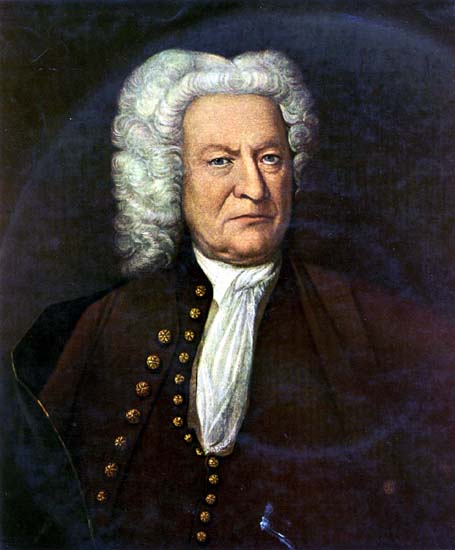
Vor deinen Thron tret ich hiermit
Some Preliminary Conclusions About the Authenticity of the Volbach Portrait
Throughout the process of demonstrating that the Weydenhammer Portrait Fragment is, in fact, not only an accurate and authentic
depiction of the face of Johann Sebastian Bach and a portrait from life but also what remains of the long lost portrait of Johann
Sebastian Bach that belonged to Johann Christian Kittel, I have been haunted by the powerful image that is the Volbach Portrait.
This compelling and deeply moving oil painting has been with me since practically the first day of my interest in Johann Sebastian
Bach. The reader, therefore, will forgive, I hope, the following rather lengthy autobiographical tangent. My devotion to the music of
Sebastian Bach began when I was in the first grade, and, during that academic year, my parents made a trip to Europe. My mother
brought me back some postcards, including two portraits of Bach. One was the 1746 Haussmann portrait of Bach, an image which
I already knew, believe it or not, from a Bach Aria Group flyer that featured, of course, the much better preserved version, the 1748
Haussmann portrait of Bach and that had been given to me by the Lower School music teacher at the Buckley School in New York.
The other was a black and white postcard of the Volbach Portrait. Believe it or not, I still have both of those postcards, 47 years
later. They are now framed, but for many years they were carefully tucked inside the back cover of my copy of Charles Sanford
Terry's Johann Sebastian Bach - A Biography. Here is, for sentiment's sake, are scans of those cards:
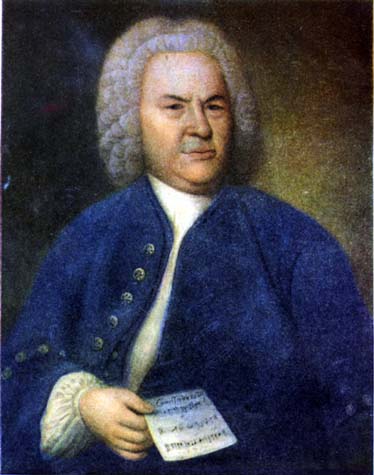

The caption on the back, the message side, of the Volbach Portrait postcard reads: Altersbild eines unbekannten Meisters aus dem
Besitz von Prof. Volbach. By that time, the Professor Volbach was not Fritz Volbach (1861-1940), who had acquired the painting
in 1903, while he was living and working in Mainz, but his son, Walther R. Volbach, but I shall return to Walther later.
The depiction, stark, dour, and severe, did not appeal to me much when I was a child, which should come as no surprise, but its
power stayed with me nonetheless. I confronted the Volbach Portrait again, while in prep school at Deerfield Academy in Deerfield,
Massachusetts, twice, and within a short period of time. The first encounter was a large color version of the painting that is the
cover art for a 10" Cantate LP recording of the motet Jesu, meine Freude, BWV 227, conducted by Wilhelm Ehmann. It is that
version that I scanned for the color images that presently appear at The Face Of Bach. It was shortly thereafter that I had the
fortuitous and serendipitous encounter with Gerhard Herz's perceptive and meticulous 1957 review (Musical Quarterly, Vol. XLIII,
pp. 116-122) of Heinrich Besseler's Fünf echte Bildnisse Johann Sebastian Bachs, (Bärenreiter, Kassel, 1956), that confirmed
once and for all my obsession with the Bach iconography and that propelled me down the road that now, more than 35 years later,
has culminated in The Face Of Bach.
I learned from Gerhard's review that the painting had come to the United States and that it was in Fort Worth, Texas, where Fritz
Volbach's son, Walther, who had inherited it, taught Theater Arts at Texas Christian University. I wrote to Prof. Volbach, the
distinguished disciple of Appia, and asked if I might have a color photograph of the painting. He wrote back that he didn't have
one, but that he could arrange to have one made for $35, which was worth a lot more in 1963 than it is today. I got the money
together, and he had the color transparency made. I still have that, too.
The following year, I heard from Prof. Volbach again. He had retired from Texas Christian and had accepted an appointment at the
University of Massachusetts in Amherst, which is but a short distance from Deerfield Academy. I prevailed upon a faculty member
to take me over to visit him and his wife and to see the original painting. I shall always remember Prof. Volbach's astonishment
when he discovered that I was a student, not a faculty member. Another classmate, who is a superb organist and harpsichordist and
now the Director of Music at a distinguished church in the Boston suburbs, went along.
I recall that the painting was smaller than I had expected. (I remember that I had a similar reaction when I saw the 1748 Haussmann
portrait for the first time.) But the image's power, like that of the 1748 Haussmann portrait and the Weydenhammer Portrait
Fragment, was immediate and undeniable.
I visited with Prof. Volbach, who quickly became Walther, and his lovely wife Claire several times during the remainder of my days
in the Pocumtuck Valley, and we stayed in touch while I was at Princeton. Then, after I went off to law school, I lost track of them.
The years went by, but my obsession with the portraits of Bach did not ebb, as those who have read the pages that have preceded
this one know only too well. I knew both from Walther and from a somewhat snide remark that Prof. Neumann makes in his
account of the painting in Bilddokumente zur Lebensgeschicte J. S. Bachs that Walther had tried unsuccessfully to sell the painting.
Then a few years ago I saw Walther's obituary in the New York Times. He had lived to be 98. When I read the obituary of a
wonderful man who had been so kind to me when I was much younger, I recalled what Tab Hunter said to me one day, over 20
years ago, when my big blond, John McMurray, and I had lunch with him: "Assumptions are the mother of all foul ups". I had
assumed that dear Walther had long since crossed to the other side. Had I known that he was still living in Amherst, I certainly
would have stopped to visit him on my occasional visits to Deerfield Academy.
I wondered, of course, what had become of the portrait, but I turned my mind to other things.
And then in June of 1999, I received an e-mail from Walther's nephew, who is named Fritz, after his grandfather. Like the
great-granddaughter of Edward Weidenhammer who got in touch with me about the Weydenhammer Portrait Fragment, he had seen
the page on the Bach portraits that I had begun to construct at my home pages.
So, yet again, the Internet proves to be an amazing innovation.
When I announced the discovery of the Weydenhammer Portrait Fragment on the 31st of July, 2000, I included Fritz on the list of
recipients of the e-mail announcement that resulted in the construction of the original versions of the The Face of Bach web pages
(most of which either have been completely supplanted by new pages or presently are "off line" for revision) on much shorter
notice than I ever had intended.
I received a message of congratulations, and, when I acknowledged his kind words of praise, I told him that my next task was to
deal with the Volbach Portrait. A new reference 8x10 transparency has recently been made, and I hope soon to begin to work with
that image to fine tune the evaluation that follows, just as I promised Fritz I would in August, 2000. I also hope that, during the
forthcoming winter, I shall be able, finally, to travel west to San Francisco, where the portrait now is, to see it first hand again, for
the first time since 1965. My standards, my approach, my criteria, obviously, are much higher and more rigorous now, than they
were in 1965, and I shall, as Bill Scheide has instilled it into me, go where the evidence takes me, no matter what.
But...
But...
The Volbach Portrait haunted me, and it haunted me insistently throughout the summer of 2000. It demanded that I deal with the
question of its authenticity, and that I deal with it at the same time that I began my initial evaluation of the Weydenhammer Portrait
Fragment.
I was not ready or prepared to deal with this insistent demand, but, finally, I relented.
During one of my intitial discussions with Bill Scheide about the Weydenhammer Portrait Fragment, the Volbach Portrait came up.
He asked how the Volbach Portrait could possibly be Bach, when his painting, the 1748 Haussmann portrait, can be no more than
two to four years older. I thought of the poignant and heart rending descriptions of Bach's last weeks and months that one finds not
only in Christoph Wolff's superb new biography, Johann Sebastian Bach, The Learned Musician, but also in Charles Sanford
Terry's Johann Sebastian Bach - A Biography. I thought of my beloved big blond, emaciated from complications of HIV. I
thought of a law school chum who physically aged twenty years during a year long bout with terminal cancer. I cited this last
specific example to Bill.
Bill, quite correctly, reminded me that there is no evidence that Bach died of cancer. I agreed, but it was not until after I had hung
up the phone that I realized that, yet again, as he has so many times before, my dear friend and treasured mentor had given me the
key.
So, without new reference photos, without having seen my old friend in 35 years, without examining it, front and back, without a
detailed knowledge of its restoration history, I put the Volbach Portrait, the inscrutable Volbach Portrait, the insistent Volbach
Portrait, the painting that sat on my shoulder like the clichéed monkey, through the same rigorous examination to which I subjected
the Weydenhammer Portrait Fragment.
After I have had my reunion with this powerful image, after I have studied it "in the flesh", and now that I have a new reference
photo in hand, I reserve the right, of course, to revise all of this, to refine the conclusions that I am about to share with you.
So, for the moment, to quote Admiral Farragut's exhortation to his crew in Mobile harbor in 1864, "Damn the torpedoes! Full speed
ahead!"
The widespread resistance to the possibility that the Volbach Portrait might be an authentic and accurate depiction, taken from life,
of the face of Johann Sebastian Bach is based essentially on two grounds:
Few can bring themselves to believe that Bach could have aged so much after the Haussmann portraits were painted; and
There are not only no known contemporary references to the image but also no known solid reasons for its existence, for its
having been painted during the last weeks of Bach's life.
Please, therefore, let me begin by discussing the question of Bach's appearance during the last months of his life, because, as I
previously have observed, if the Volbach Portrait is to be acknowledged as a genuine, authentic, and accurate portrait from life of
Johann Sebastian Bach, it has to have been painted during the last months, if not the last weeks, of his life.
As Christoph Wolff so cogently has demonstrated, Bach's health deteriorated quickly, and it is clear that, by the late spring of 1749,
he was most unwell. That the collapse was precipitous, like a falling house of cards, is made clear by the fact that, while Bach had
been able to put on a full scale performance of the Johannespassion, BWV 245, on Good Friday, April 4, 1749, by June 2, 1749,
the Saxon prime minister, Graf von Brühl, was able to write to one of the Leipzig burgomasters and, in essence, demand that the
director of his private musical establishment, Gottlob Harrer, be allowed at once to audition to succeed to the posts of
Thomascantor and Director musices of the City "upon the eventual...decease of Mr. Bach." (Wolff, JSBTLM, 2000, p. 442, footnote
omitted) Bach rallied, however; on June 19, he took holy communion in the Thomaskirche, and, on August 25, at the annual
Rahtswechsel service, he put on a performance of the elaborate and festive Cantata, Wir danken dir, Gott, wir danken dir, BWV
29. For this performance, he himself wrote out a new continuo part for the "Sinfonia", a part that graphically shows how much his
handwriting had deteriorated. (Wolff, JSBTLM, 2000, p. 444-445) Bach's last known signature is on a letter dated December 11; by
December 27, he was no longer able even to sign his name; on the last document that he is known to have dictated, "the signature
was supplied by a scribal hand." (Wolff, JSBTLM, 2000, p. 447, footnote omitted)
It was at the end of March, 1750, sometime between the 28th of the month and the 31st, that Bach was operated on for the first time
by the esteemed English ophthalmic surgeon, Chevalier John Taylor, one of the pioneers of modern eye surgery.
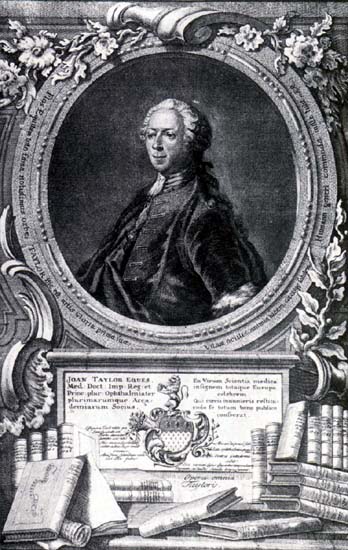
"Taylor, a specialist in cataract operations, was well respected, and by no means a charlatan." The first operation was not
successful, and between April 5 and April 8, 1750, Taylor operated on Bach's eyes again. The "operation..., as the Obituary
[prepared by C. P. E. Bach and Agricola] states failed; matters were made worse by 'harmful medicaments and other things'..."
(Wolff, JSBTLM, 2000, p. 448, footnote omitted)
In his autobiography, published in 1761, Taylor himself acknowledged that the operations on Bach's eyes had been unsuccessful:
"...at Leipsick, where a celebrated master of music, who had already arrived to his 88th year, received his sight by my
hands; it is with this very man the famous Handel was first educated, and with whom I once thought to have had the
same success, having all the circumstances in his favor, motions of the pupil, light, etc., but upon drawing the curtain,
we found the base defective, from a paralytic disorder." (Quoted by Wolff, JSBTLM, 2000, p. 449, footnote omitted)
For our particular purposes, what is the import of this sad tale?
First, the deterioration in Bach's health, and the resulting toll that it must have taken on his physical appearance, did not begin until
at least six months after the latest possible date for the painting of the 1748 Haussmann portrait.
Second, no one seems ever to have stopped to assess carefully the significance and the implications of Chevalier Taylor's
recollection of the event, more than a decade later. First of all, that he could have confused Bach's name with that of Handel's
teacher, Friedrich Wilhelm Zachow (or Zachau) is understandable; after all, Dr.Taylor was an Englishman writing many years after
the fact, and the first syllable of Zachow's name rhymes with Bach.
But what is even more significant is Taylor's specific statement that "the celebrated master of music" was in his 88th year. (Zachow,
who was born in 1663, would have, in fact, been in his 88th year in 1750.) Had Bach's physical appearance been as it is in the 1748
Haussmann portrait, there is little likelihood that, even in retrospect, Taylor, a physician and surgeon, would have believed for a
nano-second that his Leipzig patient had been 87 going on 88.
If, however, the man upon whose eyes Taylor operated looked like the man in the Volbach Portrait, such an error could easily be
made.

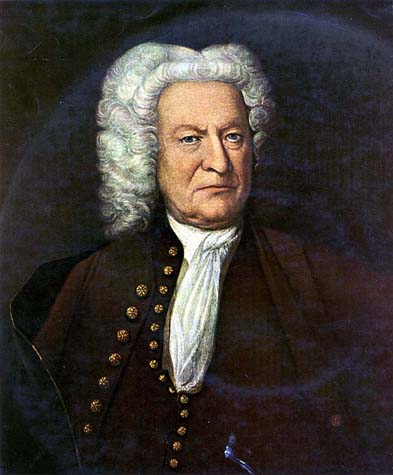
Now, a comparison, anatomical detail by anatomical detail of the face in the Volbach Portrait with the face in the 1748 Haussmann
Portrait, focussing on the physiognomical characteristics that an accurate and authentic depiction of the face of Johann Sebastian
Bach must have.
As I did in demonstrating that the Weydenhammer Portrait Fragment is an authentic and accurate depiction of the face of Johann
Sebastian Bach, I shall begin at the top, and work downwards. Once again, I shall use the 1748 Haussmann Portrait as the absolute
standard, but, yet again, I shall also include the equivalent details from the 1746 Haussmann Portrait as a reminder that that painting,
sadly, is not reliable for comparison purposes. The details from the 1748 Haussmann portrait are on top, or to the left, as the case
may be, the details from the Volbach Portrait are in the center, and the details from the 1746 Haussmann Portrait are on the bottom
Finally, unless otherwise indicated, left and right are from Bach's perspective.
But, before I focus on the face, please let me point out that the similarity of the basic pose in these two "brustbilder" allows one to
compare the slope of Bach's shoulders. He slouched, so to speak, as some might expect of a keyboard player, and the distance
from his neck to the juncture of shoulder and upper arm (I hope the doctors and scientists who are reading this will forgive the
artless inexactness of my descriptive language!) seems to be greater, and the angle of the slope thus less acute, on his left side than
it does on his right. Significantly, this subtle anomaly, which is apparent in both the 1746 and the 1748 Haussmann Portraits, is also
apparent in the Volbach Portrait. The sharper angle of the junction of the right sleeve with the body of the coat in the Volbach
Portrait also reinforces my contention that the Bach of the Volbach Portrait weighed significantly less than the Bach of the
Haussmann Portraits.
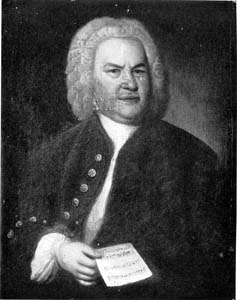

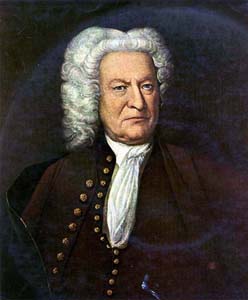
And now the direct comparison of the faces.
First, the faces, without the distractions of perruques and costumes:
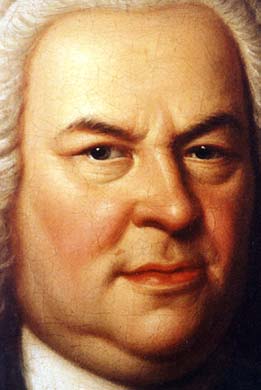


I do not have any trouble at all concluding that the face in the center is the face on the left and on the right, affected by serious,
ravaging, and enduring illness.
And now the specific comparisons, detail by detail, beginning with the distinctive, furrowed brow. (I apologize for the relatively
small size of the images, but, pending the arrival of the recently made 8x10 transparency of the painting, I am limited by the relative
graininess of the available image. Larger scans will supplant these as soon as it is feasible.)



The asymmetry, the distinctive arch, and the upward creases are the same, but there has been significant hair loss. One can still
make out the arches of the brow, but there is much less hair, a logical effect of stressful illness.
Now, the eyes:



Once again, the similarities are astonishing. Because of the graininess of the photograph of the Volbach Portrait it is difficult to
clearly analyze the right-hand portion of the drooping eyelid over the right eye, but the distinctive fold that the drooping eyelid takes
as it meets the bridge of the nose is not only in the same location but also more pronounced in the Volbach Portrait, which would
make sense if it had been painted at least a year and a half after the 1748 Haussmann portrait. The drooping eyelid over the left eye
lags behind that of the right, as it does in the 1748 Haussmann portrait. Also, the distinctive curve of the portion of the lower right
lid nearest to the bridge of the nose appears to be the same.
Until I have seen and studied at least the new 8x10 transparency, if not the original of the Volbach Portrait itself again, however, I
shall offer no firm comment on the color of the eyes, but I will make the observation that the color is blue-grey in the reproduction
used for this initial comparison. Also, the bags beneath them appear to be the same.
I continue, however, to be struck by the peculiar rendering of the left eye; the watery, cloudy nature of the base of the pupil
supports, I think, my personal belief that the Volbach Portrait was painted after the eye operations.
Next the nose:



Yet again, the similarities are astonishing. Again, the graininess of the photo of the Volbach Portrait is something of an impediment,
but the essential shape of the nose is identical, and the little ridge on the lefthand side of the bridge of the nose about a third of the
way down can be made out. And, sadly, the nose of the 1746 Haussmann Portrait is one of the areas in which the damage has made
it unreliable for comparison purposes.
And, now the mouth and jaw. As I have shown elsewhere, in an analysis of the essential elements of Bach's facial physiognomy, an
underbite, a protuberant lower jaw, and the absence of teeth are essential.

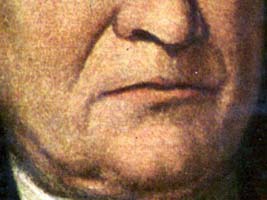
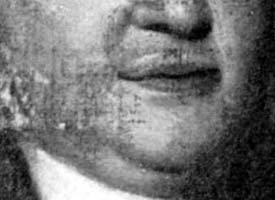
Once again, the essential elements appear to be present. The lower jaw appears to protrude beyond the upper one, and the upper lip
is sunken on the left hand side in the same spot that it appears to be in the 1748 Haussmann portrait. The shape of the right hand
side of the lip is clearly different, however, and the distinctive creases are longer. These differences in detail are telling. First, it
might be indicative of the loss of additional teeth between 1748 and the spring of 1750. Secondly, Chevalier Taylor makes a specific
reference to a paralytic disorder. Is it possible that the beginnings of the deterioration of Bach's health are attributable to a stroke
and that he suffered at least one, and perhaps tw0 more, before his death? It certainly would comport neatly with the kind of
essential physical problems that Christoph Wolff suggests were the root cause of Bach's last illness. A mild stroke would also
neatly explain (1) why Graf von Brühl moved with all deliberate speed to railroad the Leipzig Town Council into audtioning Bach's
eventual successor, Gottlob Harrer, (2) Bach's recovery in the summer of 1749 and (3) the initial problems with his handwriting,
particularly if the stroke was on the right hand side, and I know of no evidence to suggest that Bach was left-handed. As Christoph
Wolff has demonstrated, Bach was not able even to sign his own name after December 27, 1749, an indication of yet another
stroke.
Of course, the effects of the strokes provides a cogent and logical explanation of the "problem" of the dimple or cleft in the chin
that Bach seems to have in the Volbach Portrait. I have examined the issue in some detail in The Queens College Lecture of March
21, 2001, The Face Of Bach - The Search for the Portrait that Belonged to Kittel, so, for the purposes of this analysis, suffice it
to say, that the Bach of the 1746 and 1748 Haussmann portraits was corpulent, to phrase it politely, and certainly a minimum of 25
to 30 pounds heavier than the Bach of the Weydenhammer Portrait Fragment or the Bach of the Volbach Portrait. The loss of
weight that was an inevitable by-product of the rigors of Bach's precipitous physical decline and the associated health problems,
including at least one, and possibly as many as three strokes, before the stroke that ultimately caused his death on July 28, 1750,
surely would have "uncovered" the cleft that the the subcutaneous fat obscures in both the 1746 and 1748 Haussmann portraits.
As far as I am concerned, the Volbach Portrait passes the physiognomical comparison test convincingly, but is there anything else
about this extraordinary image that might independently support the conclusion that it is a portrait from life of Johann Sebastian
Bach painted in the last months of his life? As it happens, there is. First, let's look at the the Volbach Portrait together with both the
1746 and 1748 Haussmann portraits again.



One cannot help but be struck by the fact that, with one telling exception, the pose in the Volbach Portrait is for all practical
purposes the same as that of the the 1746 and 1748 Haussmann portraits. That significant exception, of course, is the Volbach
Bach is not proffering a copy of the Canon triplex à 6 vocibus to the viewer. Instead, almost symbolically if one believes, as I do,
that Bach was partially disabled, if not paralyzed, on the right side during the last months of his life, his right arm is shrouded by the
cape that has been draped around his shoulders. How else could Sebastian Bach send a message to the knowledgeable spectator
that this portrait does, in fact, depict the same man as the 1746 and 1748 Haussmann portraits? Anyone who has spent any time
studying Johann Sebastian Bach is well aware of his obsession with numbers, numerology, and numerological equivalents, and also
knows that the Bach number is 14. (B=2 + A=1 + C=3 + H=8 = BACH=14) I cannot believe that in 35 years I never had bothered
to count the buttons, but until the morning on which I relented and, ready or not, wrote this essay, I never had.
There are seven buttons on the coat, and 14 on the waistcoat. That one set of buttons is the Bach number, and the other is half that
number cannot be coincidental, and it suggests compellingly that, in fact, whether he could see it or not, Bach did have "input" into
the form and substance of the portrait. The presence of the 14 buttons on the waistcoat reflects the reality, first noticed by the great
Bach scholar Friedrich Smend a half a century ago, that the total number of buttons on the jacket and vest of the 1746 Haussmann
Portrait is 14. (Why there are a total of 17 buttons either wholly or partially visible on the garments of the 1748 Haussmann Portrait
is an anomaly that has yet to be explained.) And, the total number of button holes visible on the garments of the Berlin Portrait is
also 14.
And now, what about the issue of why?
Why and for whom was the Volbach Portrait painted?
The answers to that question remain to be ascertained, but, in light of the fact that it appears that we are, in fact, dealing with a
genuine portrait from life of Johann Sebastian Bach, painted in the last weeks of his life, research into issues that only a few days
ago seemed of little significance now becomes both important and imperative.
First, for whom was it painted, and why? I believe that I have figured that out, and that, ironically, the answers have been in front of
us all the time. I have not had the opportunity to test the hypothesis thoroughly, however, and I shall not advance it until I have
tested and refined my explanation thoroughly. Suffice it to say, however, that it would come as no surprise to me if my hunch that
Elias Gottlob Haussmann was the as yet unidentified artist who painted the Volbach Portrait turns out to be accurate.
But, one thing is now certain. Like it or not, those of us who are fascinated by the Bach iconography now must come to grips with
the inscrutable Volbach Portrait. So far, the arguments in favor of its being both genuine and an accurate depiction of the face of
Johann Sebastian Bach far outweigh the arguments against.
No longer can the Bach scholarly community turn its back on the Volbach Portrait, a shattering image, an image that shows Johann
Sebastian Bach as he prepared to cross from this world to the next.
Wenn wir in höchsten Nöten sein.
Lieber Herr Gott, wecke uns auf...
Vor deinen Thron tret ich hiermit.
Teri Noel Towe
August 28, 2000
Revised April 11, 2001
Please click on  to return to the Index Page at The Face Of Bach.
to return to the Index Page at The Face Of Bach.
Please click on  to visit the Johann Sebastian Bach Index Page at Teri Noel Towe's Homepages.
to visit the Johann Sebastian Bach Index Page at Teri Noel Towe's Homepages.
Please click on the 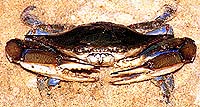 to visit the Teri Noel Towe Welcome Page.
to visit the Teri Noel Towe Welcome Page.
TheFaceOfBach@aol.com
Copyright, Teri Noel Towe, 2000 , 2002
Unless otherwise credited, all images of the Weydenhammer Portrait: Copyright, The Weydenhammer Descendants, 2000
All Rights Reserved
The Face Of Bach is a PPP Free Early Music website.

The Face Of Bach has received the HIP Woolly Mammoth Stamp of Approval from The HIP-ocrisy Home Page.